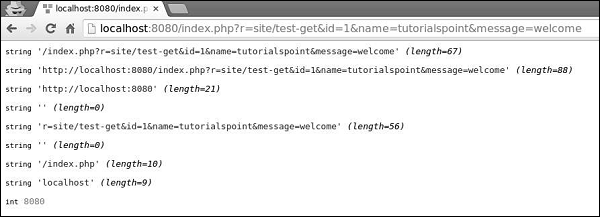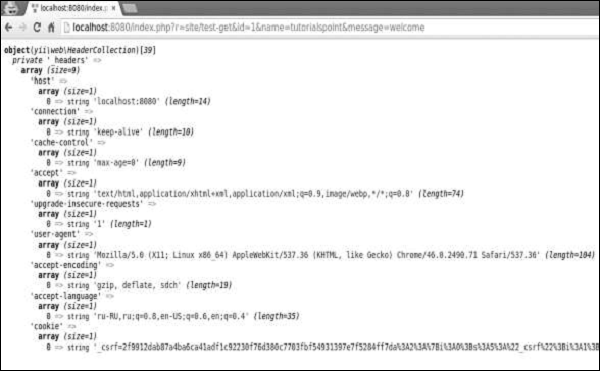Запросы представлены объектом yii \ web \ Request , который предоставляет информацию о заголовках HTTP, параметрах запроса, файлах cookie и т. Д.
Методы get () и post () возвращают параметры запроса компонента запроса.
Пример —
$req = Yii::$app->request; /* * $get = $_GET; */ $get = $req->get(); /* * if(isset($_GET['id'])) { * $id = $_GET['id']; * } else { * $id = null; * } */ $id = $req->get('id'); /* * if(isset($_GET['id'])) { * $id = $_GET['id']; * } else { * $id = 1; * } */ $id = $req->get('id', 1); /* * $post = $_POST; */ $post = $req->post(); /* * if(isset($_POST['name'])) { * $name = $_POST['name']; * } else { * $name = null; * } */ $name = $req->post('name'); /* * if(isset($_POST['name'])) { * $name = $_POST['name']; * } else { * $name = ''; * } */ $name = $req->post('name', '');
Шаг 1 — Добавьте функцию actionTestGet в SiteController базового шаблона приложения.
public function actionTestGet() { var_dump(Yii::$app->request->get()); }
Шаг 2 — Теперь перейдите по адресу http: // localhost: 8080 / index.php? R = site / testget & id = 1 & name = tutorialspoint & message = welcome , вы увидите следующее.
Чтобы получить параметры других методов запроса (PATCH, DELETE и т. Д.), Используйте метод yii \ web \ Request :: getBodyParam () .
Чтобы получить метод HTTP текущего запроса, используйте свойство Yii :: $ app → request → method .
Шаг 3 — Измените функцию actionTestGet, как показано в следующем коде.
public function actionTestGet() { $req = Yii::$app->request; if ($req->isAjax) { echo "the request is AJAX"; } if ($req->isGet) { echo "the request is GET"; } if ($req->isPost) { echo "the request is POST"; } if ($req->isPut) { echo "the request is PUT"; } }
Шаг 4 — Перейдите на http: // localhost: 8080 / index.php? R = site / test-get . Вы увидите следующее.
Компонент запроса предоставляет множество свойств для проверки запрошенного URL.
Шаг 5 — Измените функцию actionTestGet следующим образом.
public function actionTestGet() { //the URL without the host var_dump(Yii::$app->request->url); //the whole URL including the host path var_dump(Yii::$app->request->absoluteUrl); //the host of the URL var_dump(Yii::$app->request->hostInfo); //the part after the entry script and before the question mark var_dump(Yii::$app->request->pathInfo); //the part after the question mark var_dump(Yii::$app->request->queryString); //the part after the host and before the entry script var_dump(Yii::$app->request->baseUrl); //the URL without path info and query string var_dump(Yii::$app->request->scriptUrl); //the host name in the URL var_dump(Yii::$app->request->serverName); //the port used by the web server var_dump(Yii::$app->request->serverPort); }
Шаг 6 — В адресной строке веб-браузера введите http: // localhost: 8080 / index.php? R = site / testget & id = 1 & name = tutorialspoint & message = welcome , вы увидите следующее.
Шаг 7 — Чтобы получить информацию заголовка HTTP, вы можете использовать свойство yii \ web \ Request :: $ headers . Модифицируйте функцию actionTestGet таким образом.
public function actionTestGet() { var_dump(Yii::$app->request->headers); }
Шаг 8. Если вы перейдете по URL-адресу http: // localhost: 8080 / index.php? R = site / testget & id = 1 & name = tutorialspoint & message = welcome , вы увидите вывод, как показано в следующем коде.
Чтобы получить имя хоста и IP-адрес клиентского компьютера, используйте свойства userHost и userIP .
Шаг 9 — Модифицируйте функцию actionTestGet таким образом.
public function actionTestGet() { var_dump(Yii::$app->request->userHost); var_dump(Yii::$app->request->userIP); }
Шаг 10 — Перейдите по адресу http: // localhost: 8080 / index.php? R = site / test-get и вы увидите следующий экран.



